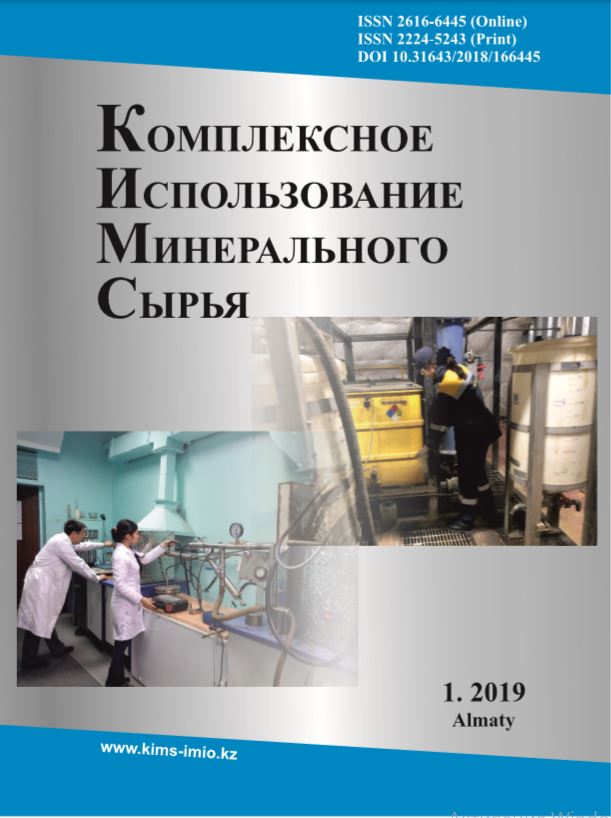The mechanical activation as an efficient method for the improvement of perovskit technology
DOI:
https://doi.org/10.31643/2019/6445.02Keywords:
perovskite, mechanical activation, hydrated product, titanium dioxide, anatase, rutile.Abstract
The effect of high-voltage mechanical energy of planetary mill on a solid hydrated product isolated by the treatment of perovskite with nitric acid has been established. The transformation includes several physicochemical steps such as dispersion of the particles, amorphization of their surface and formation of structural defects. It leads to approximately twofold increases in the specific surface area and porosity of the particles. The best result of mechanical activation was achieved at rotation speed of 650 rpm for 4-5 hours due to high hardness of rutile and anatase contained in hydrated products. The mechanical activation markedly increases the chemical activity of the hydrated product at the step of treatment with sulfuric acid of 700-900 g/l H2SO4. The kinetic curves show the reduction in time of the induction period due to increasing in the dissolution rate of the amorphous layer in the hydrated product particles. Also the extraction of TiO2 into sulfuric acid liquid phase up to 85 % and 76 % respectively, depending on the conditions (in air atmosphere or in an autoclave). At the concentration of 700 g/l H2SO4 a stable liquid system is observed without any sulphate precipitates. Increase in H2SO4 concentration up to 900 g/l markedly accelerates the extraction process. However, increased acidity reduces the stability of the system and promotes formation of TiOSO4•H2O compound in the. The obtained results can be used to improve the nitric-sulfuric acid technology of perovskite.
Downloads
References
Mitrofanova G.V., Gromov Ye.V., Artem'yev A.V., Chernousenko Ye.V. Otsenka effektivnosti kompleksnoy pererabotki bednykh apatito-nefelinovykh rud, soderzhashchikh redkiye i redkozemel'nyye metally(Evaluation of the effectivenessof complex processing of poor apatite-nepheline ores containing rare and rare-earth metals).Tsvetnyye metally = Non-ferrous metals. 2018. 8, 7-15 (in Russ.). https://doi.org/10.17580/tsm.2018.08.01
Krysenko G.F., Epov D.G., Medkov M.A., SitnikP.V., Nikolayev A.I. Vskrytiye perovskitovogo kontsentrata gidrodiftoridom ammoniya(Opening of perovskite concentrate with ammonium difluoride). Khimicheskaya tekhnologiya = Chemical Technology. 2015. 16; 4, 219-223 (in Russ.)
Sitnik P.V., MedkovM.A. REE formation in hydrodifluoride processing of the perovskite concentrate. Theoretical Foundations of Chemical Engineering. 2016. 50; 5,867-871https://doi.org/10.1134/S0040579516050122
Nikolayev A.I., Gerasimova L.G., Petrov V.B., Mayorov V.G. Perovskitovyy kontsentrat-perspektivnoye netraditsionnoye syr'ye dlya proizvodstva titanovoy i redkometall'noy produktsii(Perovskiteconcentrate is a promising unconventional raw material for the production of titanium and rare-metal products)Kompleksnoye ispol'zovaniye mineral'nogo syr'ya. 2015. 2,26-34(in Russ.).
Gerasimova L.G., Mel'nik N.A., Nikolayev A.I., Shchukina Ye.S., Petrov V.B., Bychenya YU.G. Solyanokislotnaya tekhnologiya perovskitovogo kontsentrata i yeyo radioaktivnaya otsenka(Hydroacid technology of perovskite concentrate and its radioactive evaluation)Ekologiya promyshlennykh proizvodstv = Ecology of industrial productions. 2015. 1(59),54-59.(in Russ.).
Gerasimova L.G., Nikolayev A.I., Petrov V.B., Bychenya YU.G. Azotnokislotnoye razlozheniya perovskita v prisutstvii ftorsoderzhashchego reagenta(Nitric acid decomposition of perovskitein the presence of a fluorine-containing reagent)Tsvetnyye metally= Non-ferrous metals. 2017. 5, 50-53. (in Russ.). https://doi.org/10.17580/tsm.2017.05.07
Mudruk N.V., Korovina YU.V., Yelizarova I.R., Nikolayev A.I. Vydeleniye zhelezo-toriyevogo keka iz tekhnologicheskikh rastvorov posle azotnokislotnogo vskrytiya perovskitovogo kontsentrata(Isolation of iron-thorium cake from process solutions after nitric acid treatment of perovskite concentrate)Tsvetnyye metally = Non-ferrous metals. 2017. 6, 63-68(in Russ.).
Krysenko G.F., Epov D.G., Medkov M.A., Sitnik P.V., Nikolayev A.I. Vydeleniye RZE pri gidroftoridnoy pererabotke perovskitovogo kontsentrata (Isolation of REE in hydrofluoride processing of perovskite concentrate) Khimicheskaya tekhnologiya= Chemical Technology. 2015. 16;10,625-630 (in Russ.).
Perovskiy I.A., Burtsev I.N. Gidrotermal'nyy sintez sitinakita na osnove leykoksena Yaregskogo mestorozhdeniya(Hydrothermal synthesis of sitinakite based on leucoxene of the Yarega field)Vestnik Instituta geologii Komi NTS UrO RAN = Bulletin of the Institute of Geology, Komi SC UB RAS. 2013. No3 (219),16-19. (in Russ.).
KarelinV.A.,StrashkoA.N., DubrovinA.V., SazonovA.V. Research of Fluorination Process of Rutile Concentrate. Procedia Chemistry. 2014. 11, 56-62.https://doi.org/10.1016/j.proche.2014.11.011
Linkevich Ye.G., Sokolov S.V. Povedeniye perovskita v protsesse gidrometallurgicheskogo peredela (Perovskite behavior in the process of hydrometallurgical processing).Tekhnologiches-kaya mineralogiya prirodnykhitekhnogennykhmestorozhdeniy: Sb. StateyIXRossiyskogo seminarapo tekhnologicheskoy mineralogii(Technological mineralogy of natural and man-madedeposits: Sat. Articles IX Russian Seminar on Technological Mineralogy)–Petrozavodsk, Russia, 2015. 33-37(in Russ.).
Kalinkin A.M., Usoltsev A.V., Kalinkina E.V., ZverevаI.A., Chislov M.V., Nevedomskii V.N. EffectofmechanicalactivationofcoprecipitatedprecursoronsynthesisofLa2Zr2O7. Ceramics International.2016. 42; 14, 15843–15848. https://doi.org/10.1016/j.ceramint.2016.07.053
Malyshev V.P., Turdukozhayeva (Makasheva) A.M., KaykenovD.A. Razvitiye teorii izmel'cheniya rud na osnove molekulyarnoy teorii soudareniy i formal'noy kinetiki posledovatel'nykh reaktsiy(The development of the theory of grinding ores based on the molecular theory of collisions and the formal kinetics of sequential reactions)Obogashcheniye rud = Enrichment of ores. 2012. 4,29-35.(in Russ.).
Bogatyreva Ye.V. Effektivnost' primeneniya mekhanoaktivatsii(Efficiency of mechanical activation). Moscow: Publishing House MISIS. 2017, 334. (in Russ.).
Downloads
Published
How to Cite
Issue
Section
License
Copyright (c) 2022 Gerasimova, l.G., Kuzmich, Y., Shchukina, E., Maslova, M., & Kiselev, Y.

This work is licensed under a Creative Commons Attribution-NonCommercial-NoDerivatives 3.0 Unported License.


























